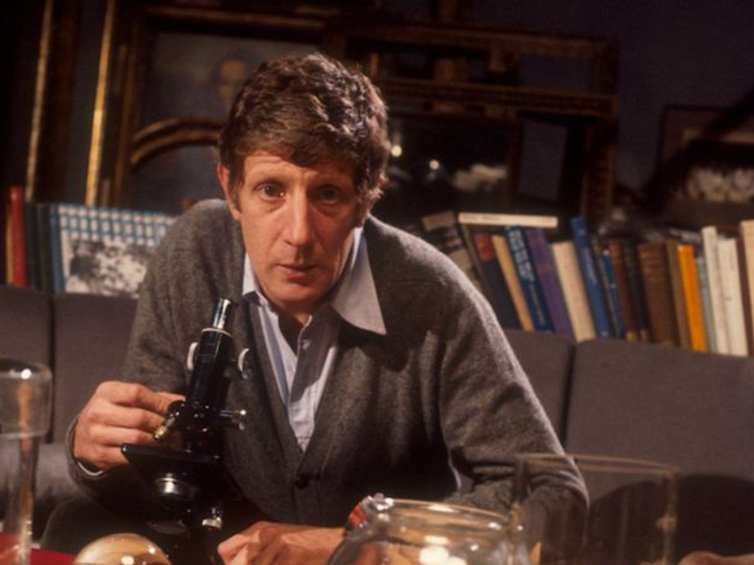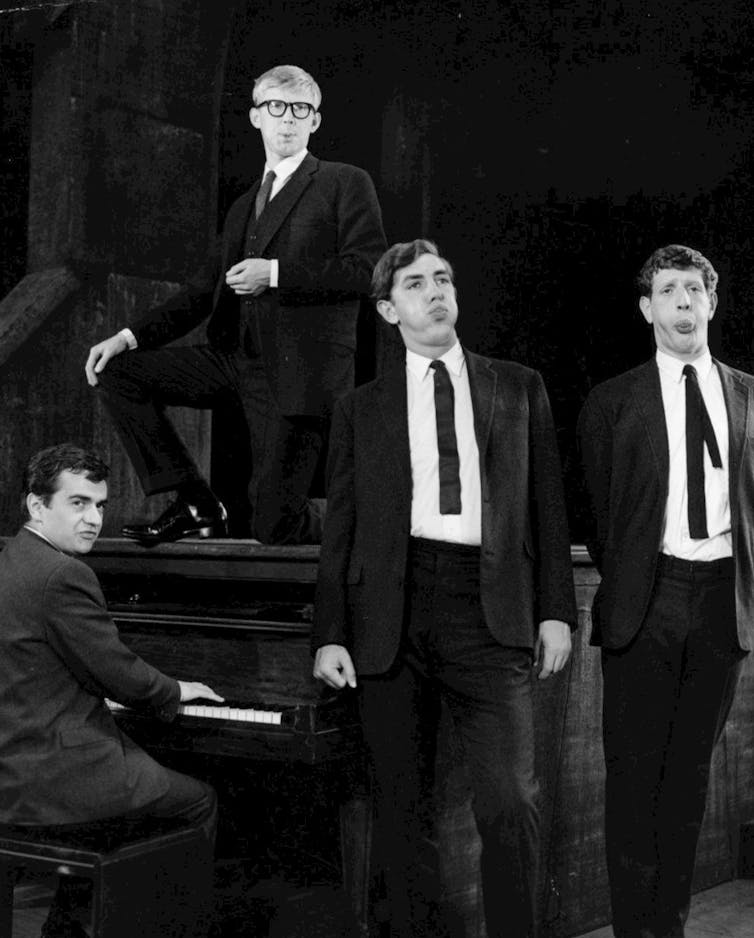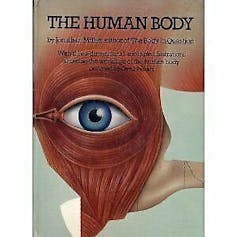
Jonathan Miller, still from The Body in Question (1978).
BBC Pictures
Rohan McWilliam, Anglia Ruskin University
Pretty much all the tributes to Jonathan Miller, who has died aged 85, end up using the term “Renaissance Man” at some point. Miller had a mastery of arts and science that few achieve – he was, at various points, a doctor, an actor, a director, a writer, a darling of the TV chat show circuit and a sculptor.
For many, he will be remembered as one of the dazzling four performers in Beyond the Fringe (along with Peter Cook, Dudley Moore and Alan Bennett), who launched in 1960 the satire boom which later gave us Monty Python. For others, Miller is known for his major documentary series, The Body in Question (1978), which – literally – opened up the body and – less literally – medical history in much the same way that Kenneth Clarke opened up Civilisation for a mass audience.
But Miller was also known for a remarkable number of pioneering theatre and opera productions, such as the English National Opera’s enduringly popular “mafia-style” Rigoletto, with its 1950s New York setting.
Miller clearly made a huge difference but how can we define his importance, especially as it was spread across so many fields?
Two cultures
Miller’s arts and science background enabled him to cross disciplinary boundaries and make exciting connections. He was the perfect riposte to the Two Cultures debate (1959-62) between F.R. Leavis and C.P. Snow, which focused on the lack of conversation between arts and science. If we consider how scholars now embrace interdisciplinarity, we should note that Miller blazed the trail.
Miller should also be viewed as one of the architects of liberal Britain in the post-war period. He rejoiced in being an irreverent free thinker (presenting a television series about his atheism) while saying, on one occasion in a lecture he gave, that censorship was about as ridiculous as adjusting one’s clothing when leaping out of a burning building. Miller paid no regard to traditional ways of presenting a play. His 1970 production of The Tempest broke new ground by presenting it as a drama about colonialism – now a standard interpretation.

Jonathan Miller, far right, in Beyond the Fringe, 1962, with, from left, Dudley Moore, Alan Bennett and Peter Cook.
Friedman-Abeles, New York
Miller was the product of what Frederick Raphael called the “glittering prizes” generation of the 1950s in which Oxbridge-educated graduates, such as theatre director Peter Hall and TV presenter David Frost, moved effortlessly into major posts in the arts and the media. A star turn in the Cambridge Footlights led Miller to Beyond the Fringe, which became a huge hit.
He performed in the show while carrying on with his medical training by day, but, having become a doctor, he was soon seduced away to become the producer of the BBC arts programme, Monitor, where his focus on figures like Susan Sontag led to accusations of pretentiousness.
Private Eye frequently ridiculed him as a “pseud”. This was not helped by his 1966 film of Alice in Wonderland, which dispensed with Lewis Carroll’s wit and interpreted the story as the adolescent dream of a girl on the verge of puberty.
The popular press wrongly claimed he was deploying Freud to sexualise a children’s story (or creating an “X-certificate Alice”). The ambition of Miller’s version is a rebuke to the more conventional literary adaptations on television today.
Theatrical trailblazer
At the National Theatre Miller directed Laurence Olivier in The Merchant of Venice (1970), adopting a Victorian setting that brought out the links between capitalism and antisemitism in the play. He quickly gained a reputation for presenting classical plays in the costumes of another period so as to emphasise a particular aspect of them. In fact, most of his productions were presented in period, paying careful attention to the visual culture of which they were a part.
He was influenced by the social psychologist Erving Goffman, which is why his productions paid careful attention to manners, hand gestures, silences and the varying protocols of conversation.
When he came to direct Eugene O'Neill’s A Long Day’s Journey into Night with Jack Lemmon (1986), he notoriously made the very long play run much shorter by having the protagonists frequently speak over each other, imitating speech patterns in ordinary life.
There was a strongly anthropological feel to his productions. Miller’s ability to make intellectual connections made him unusual among modern directors. He once complained to me that Peter Hall (with whom he had a long-running feud) never bothered to read a book. Hall, for his part, felt Miller took on the task of directing in the same spirit as if he was writing for the New York Review of Books.
It was, however, in opera that Miller really made his mark, travelling the world putting on productions for many of the great opera houses. Miller brought psychological realism to the operatic stage, insisting that singers also had to act.
Although he directed productions from across the repertoire, he had a love of Mozart as a great musical dramatist. He became a major figure in opening up opera to a wider audience, stripping the form of its exclusivity.
Miller became the producer of part of the BBC Shakespeare series in the early 1980s where he developed effective ways of doing Shakespeare by using the close up for soliloquies and employing contemporary paintings for inspiration. His Taming of the Shrew enjoyed the casting coup of John Cleese as Petruchio. When he took over the Old Vic in 1988, he produced the most intellectually ambitious repertoire that London has seen in a long time. His production of George Chapman’s Bussy D'Ambois (1603) was probably the first since the 17th century.
Two minds
Kate Bassett called her 2012 biography of Miller In Two Minds, which captures the split in his life. Miller was haunted by his decision to abandon the medical profession where he had hoped to excel.

Jonathan Miller’s pop-up book, The Human Body.
Amazon
But his restless intellectual energy was, however, a key part of the arts scene over four decades and he became a major force in making scientific knowledge available (he was happy to produce a pop-up book about the body and a book about Darwin in comic book form).
Miller felt he was never truly appreciated in his own country. Yet this was not true – he was hugely admired in Britain. Few did more to excite people about the arts and the sciences or make them confront the world of ideas in an accessible way. For those who grew up with Miller, paying tribute to him is a debt of honour.
Rohan McWilliam, Professor of Modern British History, Anglia Ruskin University
This article is republished from The Conversation under a Creative Commons license. Read the original article.